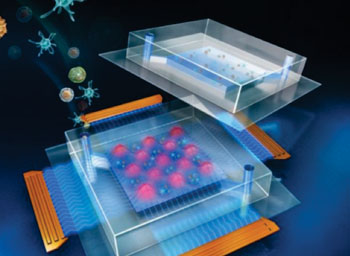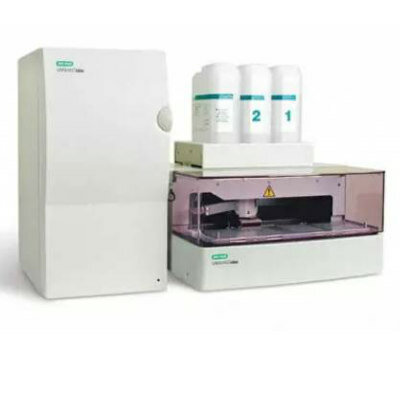Microfluidic Disposable Device Diagnoses Diseases Cheaply
|
By LabMedica International staff writers Posted on 16 Dec 2015 |

Image: Schematics of the reusable acoustic tweezers device (bottom) with a disposable microfluidic laboratory for cell manipulation and disease diagnosis (Photo courtesy of Penn State University).
The development of a reusable microfluidic device for sorting and manipulating cells and other micro/nano meter scale objects will make biomedical diagnosis of diseases cheaper and more convenient in regions where medical facilities are sparse or cost is prohibitive.
Both bulk acoustic wave (BAW) and surface acoustic wave (SAW) based approaches have shown their competency in the manipulation of macro- to nano- scale objects, regardless of an object's optical or electrical properties. A wide range of applications in static or continuous flow such as manipulating cells, moving organisms have been demonstrated by either BAW or SAW tweezers.
Scientists at the Penn State University (University Park, PA, USA) developed reusable acoustic tweezers to realize acoustic manipulation of cells or particles with a SAW platform and disposable superstrate devices. They locally transmitted standing surface acoustic waves into a removable, independent polydimethylsiloxane (PDMS)-glass hybridized microfluidic superstrate device for micromanipulation. By configuring and regulating the displacement nodes on a piezoelectric substrate, cells and particles were effectively patterned and transported into the superstrate.
The label-free and contactless nature of acoustic waves could offer a simple, accurate, low-cost, biocompatible, and disposable method for applications in the fields of point-of-care diagnostics and fundamental biomedical studies. In addition to its use in diagnosing diseases such as human immunodeficiency virus (HIV) and tuberculosis, both of which are endemic in resource-poor regions of the world, the device should find widespread use in hospitals, clinics, biology laboratories and the home due to its low cost and ease of use.
Tony Jun Huang, PhD, a professor and lead author of the study, said, “We believe our acoustic tweezers have tremendous potential, especially in diagnostics, with some applications also in therapeutics. Our current device works well, but to be used in diagnostics, the whole device has to be disposed of after one use. We have now found a way to separate the fluid-containing part of the device from the much more expensive ultrasound-producing piezoelectric substrate. This makes disposable acoustic tweezers possible.” The study was published on October 28, 2015, in the journal Lab on a Chip.
Related Links:
Penn State University
Both bulk acoustic wave (BAW) and surface acoustic wave (SAW) based approaches have shown their competency in the manipulation of macro- to nano- scale objects, regardless of an object's optical or electrical properties. A wide range of applications in static or continuous flow such as manipulating cells, moving organisms have been demonstrated by either BAW or SAW tweezers.
Scientists at the Penn State University (University Park, PA, USA) developed reusable acoustic tweezers to realize acoustic manipulation of cells or particles with a SAW platform and disposable superstrate devices. They locally transmitted standing surface acoustic waves into a removable, independent polydimethylsiloxane (PDMS)-glass hybridized microfluidic superstrate device for micromanipulation. By configuring and regulating the displacement nodes on a piezoelectric substrate, cells and particles were effectively patterned and transported into the superstrate.
The label-free and contactless nature of acoustic waves could offer a simple, accurate, low-cost, biocompatible, and disposable method for applications in the fields of point-of-care diagnostics and fundamental biomedical studies. In addition to its use in diagnosing diseases such as human immunodeficiency virus (HIV) and tuberculosis, both of which are endemic in resource-poor regions of the world, the device should find widespread use in hospitals, clinics, biology laboratories and the home due to its low cost and ease of use.
Tony Jun Huang, PhD, a professor and lead author of the study, said, “We believe our acoustic tweezers have tremendous potential, especially in diagnostics, with some applications also in therapeutics. Our current device works well, but to be used in diagnostics, the whole device has to be disposed of after one use. We have now found a way to separate the fluid-containing part of the device from the much more expensive ultrasound-producing piezoelectric substrate. This makes disposable acoustic tweezers possible.” The study was published on October 28, 2015, in the journal Lab on a Chip.
Related Links:
Penn State University
Latest Technology News
- Microneedle Patch Detects Skin Cancer Early
- New Diagnostic System Achieves PCR Testing Accuracy
- DNA Biosensor Enables Early Diagnosis of Cervical Cancer
- Self-Heating Microfluidic Devices Can Detect Diseases in Tiny Blood or Fluid Samples
- Breakthrough in Diagnostic Technology Could Make On-The-Spot Testing Widely Accessible
- First of Its Kind Technology Detects Glucose in Human Saliva
- Electrochemical Device Identifies People at Higher Risk for Osteoporosis Using Single Blood Drop
- Novel Noninvasive Test Detects Malaria Infection without Blood Sample
- Portable Optofluidic Sensing Devices Could Simultaneously Perform Variety of Medical Tests
- Point-of-Care Software Solution Helps Manage Disparate POCT Scenarios across Patient Testing Locations
- Electronic Biosensor Detects Biomarkers in Whole Blood Samples without Addition of Reagents
- Breakthrough Test Detects Biological Markers Related to Wider Variety of Cancers
- Rapid POC Sensing Kit to Determine Gut Health from Blood Serum and Stool Samples
- Device Converts Smartphone into Fluorescence Microscope for Just USD 50
Channels
Clinical Chemistry
view channel
New ADLM Guidance Provides Expert Recommendations on Clinical Testing For Respiratory Viral Infections
Respiratory tract infections, predominantly caused by viral pathogens, are a common reason for healthcare visits. Accurate and swift diagnosis of these infections is essential for optimal patient management.... Read more
3D Printed Point-Of-Care Mass Spectrometer Outperforms State-Of-The-Art Models
Mass spectrometry is a precise technique for identifying the chemical components of a sample and has significant potential for monitoring chronic illness health states, such as measuring hormone levels... Read more.jpg)
POC Biomedical Test Spins Water Droplet Using Sound Waves for Cancer Detection
Exosomes, tiny cellular bioparticles carrying a specific set of proteins, lipids, and genetic materials, play a crucial role in cell communication and hold promise for non-invasive diagnostics.... Read more
Highly Reliable Cell-Based Assay Enables Accurate Diagnosis of Endocrine Diseases
The conventional methods for measuring free cortisol, the body's stress hormone, from blood or saliva are quite demanding and require sample processing. The most common method, therefore, involves collecting... Read moreMolecular Diagnostics
view channel
Groundbreaking Molecular Diagnostic Kit to Provide Lyme Disease Detection in Minutes
Lyme disease, transmitted through tick bites, is a bacteria-caused illness that impacts 1.2 million individuals annually. The standard methods for diagnosing this disease include clinical examinations,... Read more
Novel Method Combining Nano Informatics and AI Paves Way for Cancer Blood Tests
Current diagnostic methods for cancer often fall short in terms of precision and efficiency. Traditional techniques, such as imaging scans and tissue biopsies, are invasive, costly, and time-consuming.... Read more
New Assay Detects Heart Failure Biomarker in Less than 11 Minutes
According to the Heart Failure Society of America, nearly 6.5 million Americans over the age of 20 suffer from heart failure, which accounts for about 8.5% of all heart disease deaths in the United States.... Read more
New Method for Lung Microbiomes Analysis Predicts Mortality in Children after Bone Marrow Transplant
Bone marrow transplant, also referred to as hematopoietic cell transplantation (HCT), serves as a critical treatment for children with leukemia, bone marrow failure, and various genetic disorders, including... Read moreHematology
view channel
Next Generation Instrument Screens for Hemoglobin Disorders in Newborns
Hemoglobinopathies, the most widespread inherited conditions globally, affect about 7% of the population as carriers, with 2.7% of newborns being born with these conditions. The spectrum of clinical manifestations... Read more
First 4-in-1 Nucleic Acid Test for Arbovirus Screening to Reduce Risk of Transfusion-Transmitted Infections
Arboviruses represent an emerging global health threat, exacerbated by climate change and increased international travel that is facilitating their spread across new regions. Chikungunya, dengue, West... Read more
POC Finger-Prick Blood Test Determines Risk of Neutropenic Sepsis in Patients Undergoing Chemotherapy
Neutropenia, a decrease in neutrophils (a type of white blood cell crucial for fighting infections), is a frequent side effect of certain cancer treatments. This condition elevates the risk of infections,... Read more
First Affordable and Rapid Test for Beta Thalassemia Demonstrates 99% Diagnostic Accuracy
Hemoglobin disorders rank as some of the most prevalent monogenic diseases globally. Among various hemoglobin disorders, beta thalassemia, a hereditary blood disorder, affects about 1.5% of the world's... Read moreImmunology
view channel
Blood Test Measures Immune Response to Epstein-Barr Virus in MS Patients
Multiple sclerosis (MS) is a chronic neurological condition for which there is currently no cure. It affects around three million people globally and ranks as the second most common cause of disability... Read more.jpg)
AI Predicts Tumor-Killing Cells with High Accuracy
Cellular immunotherapy involves extracting immune cells from a patient's tumor, potentially enhancing their cancer-fighting capabilities through engineering, and then expanding and reintroducing them into the body.... Read more
Diagnostic Blood Test for Cellular Rejection after Organ Transplant Could Replace Surgical Biopsies
Transplanted organs constantly face the risk of being rejected by the recipient's immune system which differentiates self from non-self using T cells and B cells. T cells are commonly associated with acute... Read more
AI Tool Precisely Matches Cancer Drugs to Patients Using Information from Each Tumor Cell
Current strategies for matching cancer patients with specific treatments often depend on bulk sequencing of tumor DNA and RNA, which provides an average profile from all cells within a tumor sample.... Read moreMicrobiology
view channel
Integrated Solution Ushers New Era of Automated Tuberculosis Testing
Tuberculosis (TB) is responsible for 1.3 million deaths every year, positioning it as one of the top killers globally due to a single infectious agent. In 2022, around 10.6 million people were diagnosed... Read more
Automated Sepsis Test System Enables Rapid Diagnosis for Patients with Severe Bloodstream Infections
Sepsis affects up to 50 million people globally each year, with bacteraemia, formerly known as blood poisoning, being a major cause. In the United States alone, approximately two million individuals are... Read moreEnhanced Rapid Syndromic Molecular Diagnostic Solution Detects Broad Range of Infectious Diseases
GenMark Diagnostics (Carlsbad, CA, USA), a member of the Roche Group (Basel, Switzerland), has rebranded its ePlex® system as the cobas eplex system. This rebranding under the globally renowned cobas name... Read more
Clinical Decision Support Software a Game-Changer in Antimicrobial Resistance Battle
Antimicrobial resistance (AMR) is a serious global public health concern that claims millions of lives every year. It primarily results from the inappropriate and excessive use of antibiotics, which reduces... Read morePathology
view channel
AI Tool Detects Tiny Protein Clumps in Microscopy Images in Real-Time
Over 55 million individuals worldwide suffer from dementia-related diseases like Alzheimer's and Parkinson's. These conditions are caused by the clumping together of the smallest building blocks in the... Read more
New Tool Enables Better Classification of Inherited Disease-Causing Variants
Whole genome and exome sequencing are increasingly available for clinical research, aiding in the detection of inherited genetic variants that may cause various diseases. The American College of Medical... Read more
Groundbreaking CRISPR Screen Technology Rapidly Determines Disease Mechanism from Tissues
Thanks to over a decade of advancements in human genetics, scientists have compiled extensive lists of genetic variations linked to a wide array of human diseases. However, understanding how a gene contributes... Read moreIndustry
view channel
Roche and Hitachi High-Tech Extend 46-Year Partnership for Breakthroughs in Diagnostic Testing
Roche (Basel, Switzerland) and Hitachi High-Tech (Tokyo, Japan) have renewed their collaboration agreement, committing to a further 10 years of partnership. This extension brings together their long-standing... Read more
Danaher and Johns Hopkins University Collaborate to Improve Neurological Diagnosis
Unlike severe traumatic brain injury (TBI), mild TBI often does not show clear correlations with abnormalities detected through head computed tomography (CT) scans. Consequently, there is a pressing need... Read more
Beckman Coulter and MeMed Expand Host Immune Response Diagnostics Partnership
Beckman Coulter Diagnostics (Brea, CA, USA) and MeMed BV (Haifa, Israel) have expanded their host immune response diagnostics partnership. Beckman Coulter is now an authorized distributor of the MeMed... Read more_1.jpg)











